 W
WBuddhist cuisine is an Asian cuisine that is followed by monks and many believers from areas historically influenced by Mahayana Buddhism. It is vegetarian or vegan, and it is based on the Dharmic concept of ahimsa (non-violence). Vegetarianism is common in other Dharmic faiths such as Hinduism, Jainism and Sikhism, as well as East Asian religions like Taoism. While monks and a minority of believers are vegetarian year-round, many believers follow the Buddhist vegetarian diet for celebrations.
 W
WGreens Restaurant is a landmark vegetarian restaurant in the Fort Mason Center in the Marina District, San Francisco, California, overlooking the Golden Gate Bridge.
 W
WThis article traces the history of cuisine of Japan. Foods and food preparation by the early Japanese Neolithic settlements can be pieced together from archaeological studies, and reveals paramount importance of rice and seafood since early times.
 W
WHong Kong cuisine is mainly influenced by Cantonese cuisine, European cuisines and non-Cantonese Chinese cuisines, as well as Japanese, Korean and Southeast Asian cuisines, due to Hong Kong's past as a British colony and a long history of being an international port of commerce. Complex combinations and international gourmet expertise have given Hong Kong the labels of "Gourmet Paradise" and "World's Fair of Food".
 W
WJapanese cuisine encompasses the regional and traditional foods of Japan, which have developed through centuries of political, economic, and social changes. The traditional cuisine of Japan is based on rice with miso soup and other dishes; there is an emphasis on seasonal ingredients. Side dishes often consist of fish, pickled vegetables, and vegetables cooked in broth. Seafood is common, often grilled, but also served raw as sashimi or in sushi. Seafood and vegetables are also deep-fried in a light batter, as tempura. Apart from rice, a staple includes noodles, such as soba and udon. Japan also has many simmered dishes such as fish products in broth called oden, or beef in sukiyaki and nikujaga.
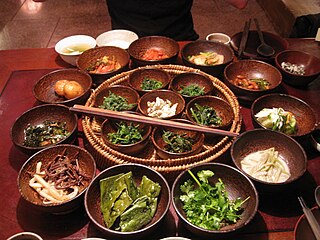 W
WKorean temple cuisine refers to a type of cuisine that originated in Buddhist temples of Korea. Since Buddhism was introduced into Korea, Buddhist traditions have strongly influenced Korean cuisine as well. During the Silla period, chalbap yakgwa and yumilgwa were served for Buddhist altars and have been developed into types of hangwa, Korean traditional confectionery. During the Goryeo Dynasty, sangchu ssam, yaksik, and yakgwa were developed, so spread to China and other countries. Since the Joseon Dynasty, Buddhist cuisine has been established in Korea according to regions and temples.
 W
WSichuan cuisine, alternatively romanized as Szechwan cuisine or Szechuan cuisine, is a style of Chinese cuisine originating from Sichuan Province. It has bold flavours, particularly the pungency and spiciness resulting from liberal use of garlic and chili peppers, as well as the unique flavour of Sichuan pepper. There are many local variations within Sichuan Province and the neighbouring Chongqing Municipality, which was part of Sichuan Province until 1997. Four sub-styles of Sichuan cuisine include Chongqing, Chengdu, Zigong and Buddhist vegetarian style.
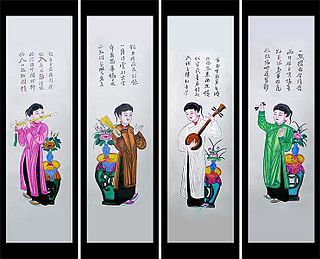 W
WVietnamese cuisine encompasses the foods and beverages of Vietnam, and features a combination of five fundamental tastes in overall meals. Each Vietnamese dish has a distinctive flavor which reflects one or more of these elements.
 W
WAuricularia auricula-judae, known most commonly as wood ear or black wood ear, is a species of edible Auriculariales fungus found worldwide. The fruiting body is distinguished by its noticeably ear-like shape and brown colouration; it grows upon wood, especially elder. Its specific epithet is derived from the belief that Judas Iscariot hanged himself from an elder tree; the common name "Judas's ear" was largely eclipsed by the corruption "Jew's ear". Today, "wood ear", "jelly ear", "tree ear", and other names are sometimes used. The fungus can be found throughout the year in temperate regions worldwide, where it grows upon both dead and living wood.
 W
WBuddha's delight, often transliterated as Luóhàn zhāi, lo han jai, or lo hon jai, is a vegetarian dish well known in Chinese and Buddhist cuisine. It is sometimes also called Luóhàn cài.
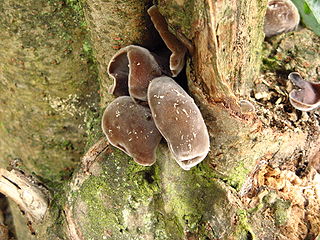 W
WCloud ear fungus is an edible jelly fungus. It grows on trees in mountainous regions, is gray-brown in color, and is often used in Asian cooking, especially Chinese cuisine.
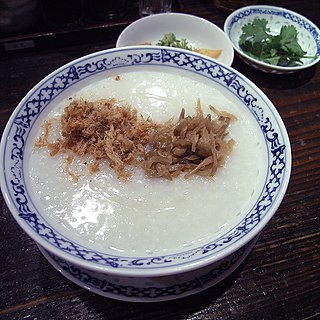 W
WCongee or conjee is a type of rice porridge or gruel eaten in Asian countries. When eaten as plain rice congee, it is most often served with side dishes. When additional ingredients such as meat, fish, and flavourings are added while preparing the congee, it is most often served as a meal on its own, especially for people who are ill. Names for congee are as varied as the style of its preparation. Despite its many variations, it is usually a thick porridge of rice largely disintegrated after prolonged cooking in water.
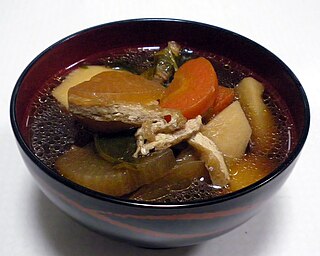 W
WKenchin jiru, also spelled kenchin-jiru, and sometimes referred to simply as kenchin, is a Japanese vegetable soup prepared using root vegetables and tofu. It is a popular dish in Japan and is prepared in various manners using myriad ingredients. It has been stated that the dish originated several centuries ago from Kenchō-ji, a temple, and it has also been suggested that the dish has its roots in shippoku cuisine.
 W
WKoya-dofu also known as Shimi-dofu, Kori-dofu, or Koyasan-dofu is frozen-dried tofu, a Japanese pantry staple and an important ingredient in Buddhist vegetarian cookery. It originated from Japan. It is made of soy, coagulants, and baking soda. It looks like a hard sponge and needs to be soaked before use. It is mainly used in stews and soups.
 W
WManjū is a traditional Japanese confection. Of the many varieties of manjū, most have an outside made from flour, rice powder, kudzu, and buckwheat, and a filling of anko, usually made from boiled adzuki beans and sugar. Manjū is sometimes made with other fillings such as chestnut jam. In Hawaii, one can find Okinawan manjū that are made with a filling of purple sweet potato, butter, milk, sugar, and salt, but the most common filling is bean paste, of which the several varieties include koshian, tsubuan, and tsubushian.
 W
WA meat analogue is a food industry term for a meat-like substance made from vegetarian ingredients. More common terms are plant-based meat, vegan meat, meat substitute, mock meat, meat alternative, imitation meat, or vegetarian meat, or, sometimes more pejoratively, fake meat or faux meat. Meat analogues typically approximate certain aesthetic qualities or chemical characteristics of specific types of meat. Many analogues are soy-based or gluten-based but now may also be made from pea protein. Other less common analogues include cottage cheese and mycoprotein.
 W
WMock duck is a gluten-based meat substitute. It is made of wheat gluten, oil, sugar, soy sauce, and salt, and is high in protein. Its distinctive flavor and artificial "plucked duck" texture distinguish it from other forms of commercially available gluten products. Mock duck is not meant to be eaten as it is and needs to be prepared, usually by lightly frying in vegetable oil.
 W
WNattō is a traditional Japanese food made from soybeans that have been fermented with Bacillus subtilis var. natto. It is often served as a breakfast food. It is served with karashi mustard, soy or tare sauce, and sometimes Japanese bunching onion. Nattō is often considered an acquired taste because of its powerful smell, strong flavor, and sticky, slimy texture. Within Japan, nattō is most popular in the eastern regions, including Kantō, Tōhoku, and Hokkaido, and a 2009 survey revealed that 70.2% of Japanese people find the taste pleasant, and others who may not find the taste of the food pleasant still eat it for health benefits.
 W
WOyaki (おやき) is a Japanese dumpling made from a fermented buckwheat dough wrapped around a stuffing of Japanese vegetables, fruit, or anko bean paste and then roasted on an iron pan. The resulting bun is then either steamed or broiled and eaten hot. Oyaki are popular and widely available in Nagano Prefecture which is famous for the dish.
 W
WPatriotic soup is a vegetable soup originated by Teochew people. It was developed during the final year of China's Song dynasty as an improvisational dish.
 W
WSansai (山菜) is a Japanese word literally meaning "mountain vegetables", originally referring to vegetables that grew naturally, were foraged in the wild, and not grown and harvested from fields. However, in modern times, the distinction is somewhat blurred, as some sansai such as warabi have been successfully cultivated. For example, some of the fern shoots such as bracken (fiddlehead) and zenmai shipped to market are farm-grown.
 W
WSeitan is a food made from gluten, the main protein of wheat. It is also known as miàn jīn, milgogi, wheat meat, gluten meat, vital wheat gluten or simply gluten. It is made by washing wheat flour dough with water until all the starch granules have been removed, leaving the sticky insoluble gluten as an elastic mass, which is then cooked before being eaten.
 W
WTakuan, or takuan-zuke, known as danmuji (단무지) in the context of Korean cuisine, is a pickled preparation of daikon radish. As a popular part of traditional Japanese cuisine, takuan is often served uncooked alongside other types of tsukemono. It is also enjoyed at the end of meals as it is thought to aid digestion.
 W
WTofu, also known as bean curd, is a food prepared by coagulating soy milk and then pressing the resulting curds into solid white blocks of varying softness; it can be silken, soft, firm, extra firm or super firm. Beyond these broad textural categories, there are many varieties of tofu. It has a subtle flavor, so it can be used in savory and sweet dishes. It is often seasoned or marinated to suit the dish and its flavors, and due to its spongy texture it absorbs flavours well. It is a traditional component of East Asian and Southeast Asian cuisines, and has been consumed in China for over 2,000 years. In modern western cooking, it is most often treated as a meat substitute.
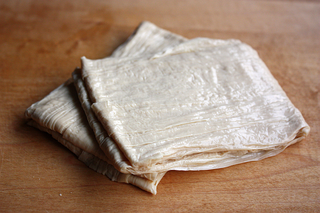 W
WTofu skin, beancurd skin, beancurd sheet, or beancurd robes is a food product made from soybeans. During the boiling of soy milk, in an open shallow pan, a film or skin forms on the liquid surface. The films are collected and dried into yellowish sheets known as tofu skin. Since tofu skin is not produced using a coagulant, it is not technically a proper tofu; however, it does have similar texture and flavor to some tofu products.
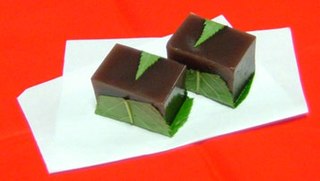 W
WYōkan is a wagashi made of red bean paste, agar, and sugar. It is usually sold in a block form, and eaten in slices. There are two main types: neri yōkan and mizu yōkan. "Mizu" means "water", and indicates that it is made with more water than usual. Mizu yōkan is often chilled and eaten in summer.